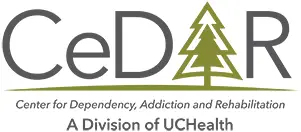PEER SUPPORT
Balanced wellness can seem overwhelming, even for those not in recovery from addiction. At CeDAR we use SAMHSA’s eight dimensions of wellness plus two cornerstones as a structure for the development of recovery after treatment. Setting and meeting specific, attainable, and measurable goals in each dimension has shown to greatly enhance long-term sobriety. It certainly can’t hurt, right?
Recovery Requires Balance
Moving away from reactionary behavior and polarized thinking into a more balanced state of being is a primary foundation for recovery. We seek to rely on many parts of our lives rather than putting all of our hopes on one or two things. Because when those things falter (as all things in life will do once in a while), there’s nothing else in place to help us overcome. We need balance to stabilize us.
Here are SAMHSA’s eight dimensions with CeDAR’s two cornerstones:
SAMHSA Dimensions and CeDAR Focus
- Emotional—Coping effectively with life and creating satisfying relationships
CeDAR focus: Non-chemical coping skills, healthy sexuality and romance, recovery-oriented family relationships, trauma and stress management, good communication, mental health care, helping others - Environmental—Good health by occupying pleasant, stimulating environments that support well-being.
CeDAR Focus: Recovery safe home & work environments; engagement in recovery community, citizenship, avoiding risky environments, being in nature - Financial—Satisfaction with current and future financial situations
CeDAR Focus: Managing debt, repayment and financial amends, paying legal fees & fines, planning for future - Intellectual—Recognizing creative abilities and finding ways to expand knowledge and skills
CeDAR Focus: Sober fun, leisure & hobbies, education and enrichment, non-chemical mental stimulation - Occupational—Personal satisfaction and enrichment from one’s work
CeDAR Focus: Recovery-safe work environment, balancing recovery and work, finding purpose - Physical—Recognizing the need for physical activity, healthy foods, and sleep
CeDAR Focus: Exercise & nutrition, accepting addiction as chronic, manageable disease, medical care with recovery-informed providers, sleep hygiene, prevention, self-care, stress management for physical health - Social—Developing a sense of connection, belonging, and a well-developed support system
CeDAR Focus: Peer support, relationship with sponsor/mentor, good citizenship, being in community (recovery and larger community), being of service - Spiritual—Expanding a sense of purpose and meaning in life
CeDAR Focus: Step work with sponsor, formal faith that supports recovery, relationship with Higher Power, recovery aligned with values
Recovery Cornerstones
- Peer Recovery—Other people in recovery who are sober
CeDAR Focus: Engaging in a mutual aid group (e.g., 12-Step fellowship), building peer support, sharing your story, connecting to the larger recovery community, being of service - Sponsor/Mentor—Someone who has experience in recovery, success in a wellness dimension, or a person of trust who will support our recovery
CeDAR Focus: Finding a sponsor, working steps of a program with a sponsor, asking our sponsor for help, sponsoring others
Connected Self
All parts of our lives touch each other. That’s why the diagram shows them in a circle with at least one point touching (the center). In fact, we are both the central hub that connects all dimensions and the entire wheel itself. Balanced wellness is achieved by maintaining health in each dimension.
Our recovery-oriented peers and mentors help us in these dimensions. We consult them for guidance and truth. They become our reliable cornerstones that can help keep the wheel from rolling away.
Goals
Start setting goals in each dimension. Make them specific, attainable, and measurable. Accomplishing smaller goals will naturally help you accomplish larger goals. Your goals should ultimately be set with one question in mind: Does this support my recovery? The answer needs to be: Yes.
